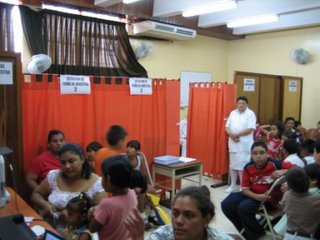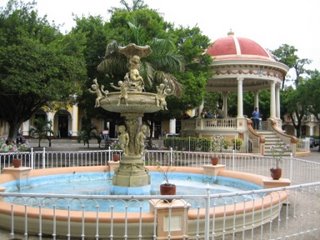Blood Draw
 The Pediatric Dengue Cohort Study is prospectively following a group of over 3000 children who live in Managua. Part of the study involves an annual blood draw from each of the children enrolled in the study. So all during the month of July they have set up a "blood draw factory" at the Socrates Flores Health Center. I spent yesterday observing the operation, and must say that I was quite impressed with the organization and sophistication of the endeavor.
The Pediatric Dengue Cohort Study is prospectively following a group of over 3000 children who live in Managua. Part of the study involves an annual blood draw from each of the children enrolled in the study. So all during the month of July they have set up a "blood draw factory" at the Socrates Flores Health Center. I spent yesterday observing the operation, and must say that I was quite impressed with the organization and sophistication of the endeavor.Each of the children enrolled in the study has a photo ID card that they present upon arrival at the health center. An
 attendent enters the child's data into a laptop computer, and then the child's thumbprint is scanned via an electronic fingerprint reader that is connected to the computer. This allows verification of the child's identity. The child then takes a seat and when his number is called by a nurse he proceeds to one of the six blood drawing stations that have been set up in the room. After his blood is drawn, he gets a lollipop and the nurse enters his information into a Palm Pilot to confirm the success of the blood draw.
attendent enters the child's data into a laptop computer, and then the child's thumbprint is scanned via an electronic fingerprint reader that is connected to the computer. This allows verification of the child's identity. The child then takes a seat and when his number is called by a nurse he proceeds to one of the six blood drawing stations that have been set up in the room. After his blood is drawn, he gets a lollipop and the nurse enters his information into a Palm Pilot to confirm the success of the blood draw.In all, over 220 children had their blood drawn yesterday. It's a huge operation, but the army of over 20 nurses kept things flowing smoothly. The majority of the children were quite stoic and endured the needle
 poking with minimal complaint. But every now and then a child would scream upon sight of the needle, thus putting uneasy all the children in the waiting area. Many kids I talked to were proud to tell me "No
poking with minimal complaint. But every now and then a child would scream upon sight of the needle, thus putting uneasy all the children in the waiting area. Many kids I talked to were proud to tell me "No  llore" (I didn't cry) or "No duele" (It doesn't hurt).
llore" (I didn't cry) or "No duele" (It doesn't hurt).The goal of this cohort study is to study the prevalence of the Dengue Virus and Dengue Antibodies in the community. In the long term, the idea is to use this information to help create a vaccine.





